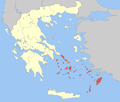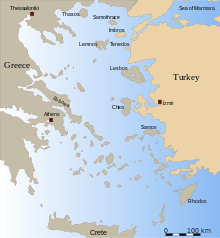Kalymnos
| Kalymnos Κάλυμνος | |
|---|---|
|
Panorama of Pothia, capital of the island | |
 Kalymnos | |
|
Location within the region  | |
| Coordinates: 36°59′N 26°59′E / 36.983°N 26.983°ECoordinates: 36°59′N 26°59′E / 36.983°N 26.983°E | |
| Country | Greece |
| Administrative region | South Aegean |
| Regional unit | Kalymnos |
| Area | |
| • Municipality | 134.5 km2 (51.9 sq mi) |
| Highest elevation | 700 m (2,300 ft) |
| Lowest elevation | 0 m (0 ft) |
| Population (2011)[1] | |
| • Municipality | 16,179 |
| • Municipality density | 120/km2 (310/sq mi) |
| Time zone | EET (UTC+2) |
| • Summer (DST) | EEST (UTC+3) |
| Postal code | 852 00 |
| Area code(s) | 224x0 |
| Vehicle registration | ΚΧ, ΡΟ, ΡΚ |
| Website | www.kalymnos-isl.gr |
Kalymnos, (Greek: Κάλυμνος) is a Greek island and municipality in the southeastern Aegean Sea. It belongs to the Dodecanese and is located to the west of the peninsula of Bodrum (the ancient Halicarnassos), between the islands of Kos (south, at a distance of 12 km (7 mi)) and Leros (north, at a distance of less than 2 km (1 mi)): the latter is linked to it through a series of islets. Kalymnos lies between two and five hours away by sea from Rhodes.
In 2011 the island had a population of 16,001, making it the third most populous island of the Dodecanese, after Kos and Rhodes. It is known in Greece for the affluence of much of its population, and also stands as both the wealthiest member of the Dodecanese and one of the wealthiest Greek islands overall. The Municipality of Kalymnos, which includes the populated offshore islands of Pserimos (pop. 80), Telendos (94), Kalolimnos (2), and Pláti (2), as well as several uninhabited islets, has a combined land area of 134.544 square kilometres (51.948 sq mi) and a total population of 16,179 inhabitants.
Naming
The island was known as Càlino in Italian and Kilimli or Kelemez in Turkish.[2]
Geography

The island is roughly rectangular in shape, with a length of 21 km (13 mi) and a width of 13 km (8 mi), and covers an area of 109 square kilometres (42 sq mi). Moreover, on the north side there is a peninsula which stretches in a northwest direction.
Kalymnos is mainly mountainous with complicated topography. There are three main chains going from W-NW to E-SE, and a fourth which innervates the peninsula. The coastline is very irregular, with many sheltered coves. There are some springs, one among them being thermal. The soil is mainly limestone-based, but in the valleys there is a compact bank of volcanic tuff, the relic of an ancient volcano, located near the village of Kantouni. The island is mainly barren, except for the two fertile valleys of Vathi and Pothia, where olives, oranges and vines are grown.
Earthquakes are a frequent occurrence around Kalymnos.
Archipelago of Kalymnos
Kalymnos is neighbored by the small island of Telendos, which was once part of Kalymnos, but split off after a major earthquake in 554 AD and is now separated from Kalymnos by a channel of water (about 800 m wide).[3]
Between Kalymnos and Kos lies the islet of Pserimos which is inhabited and, with an area of 11 square kilometres (4 sq mi), is one of the largest of the lesser islands of the Dodecanese. Near Pserimos lies the islet of Platí, and about 5 km (3 mi) to the NE lies the small islet of Kalolimnos.
History
Inhabited originally by Carians, in Antiquity Kalymnos depended on Kos, and followed its history. The island's Hellenistic Temple of Apollo was excavated by the British archaeologist Charles Newton in the nineteenth century; many of the finds he made, including important epigraphic inscriptions, are in the British Museum's collection.[4] In the Middle Ages it was under the influence of the Byzantine Empire, and during the 13th century it was used by the Venetian Republic as a naval base. In 1310 it came under the control of the Knights of Rhodes, and later (mainly in 1457 and 1460) was often attacked by the Ottomans, who eventually conquered it in 1522. Unlike Rhodes and Kos, during the Ottoman period there was no Turkish immigration to Kalymnos.
On May 12, 1912, during the Italo-Turkish War, Kalymnos was occupied by Italian sailors of the Regia Marina. Italy took control of the island along with other islands of the Dodecanese (except Kastellorizo initially) until 1947, when the Dodecanese were finally united with mainland Greece, as part of the modern Greek state.
Religion

The majority of Kalymnians are Greek Orthodox. The island belongs to that small part of Greece that does not depend on the Church of Greece, but rather on the Ecumenical Patriarchate of Constantinople based in Istanbul, Turkey. Kalymnos belongs to the Metropolis of Leros, Kalymnos and Astypalaia.
Sponge diving
Kalymnos is known and billed as the "Sponge-divers' island." Sponge diving has long been a common occupation on Kalymnos and sponges were the main source of income of Kalymnians, bringing wealth to the island and making it famous throughout the Mediterranean. The Kalymnians harvested sponges from the sea-bed as close as Pserimos or as far as North Africa. Early diving was done without equipment (free diving), using a harpoon.[5] Sponges are still fished individually, by hand.
The Greek sponge trade was centered close in the Dodecanese, featuring Kalymnos until mid-80s, when a disease hit the eastern Mediterranean destroying a great number of sponges and damaging the sponge-fishing industry as a result. Today, Kalymnos faces a lack of sponges due to the outbreak of a disease which has decimated sponge crops.
An annual celebration, Sponge Week, occurs a week after Easter to honour this "Kalymnian gold.” Much has been written, sung and filmed about the legendary courage and recklessness of the sponge divers themselves.
Climbing
Kalymnos offers rock climbing and bouldering during the whole year.
Economy
Being mostly barren (only 18% of the land can be cultivated), agriculture has always played a minor role in the economy of the island, except for the valley of Vathi. The island is famous for its citrus fruits grown in this area.
Another industrial activity typical of Kalymnos was the production of painted head scarfs, which were the most original component of the female dress.
In recent times, tourism has become important for the island, particularly for rock climbing. In 2006, the island also acquired an airport, the Kalymnos Island National Airport near Pothia, to better link the island with the mainland.
Since the beginning of the 20th century, there has been much emigration from Kalymnos (the 1925 population was some 24,000 inhabitants as compared to 16,500 in 2012), especially to the United States and Australia. The cities of Darwin and Melbourne in Australia, and Tarpon Springs, Gary, IN, and Campbell, OH in the United States are home to large Greek communities of Kalymnian descent.
Notable people
- Skevos Zervos (1875–1966) surgeon
- Nikolaos Vouvalis (1859–1918) sponge trader & Kalymnian philanthropist
- Bob Costas (1952- ) notable sportscaster of Kalymnian descent
Gallery
-
Kalymnos port from above
-
The seafront of Pothia
-
The medieval town-castle of Chorio (or Chora)
-
Emborios in the northernmost part of the island
References
- Bertarelli, L.V. (1929). Guida d'Italia, Vol. XVII (in Italian). Consociazione Turistica Italiana, Milano.
- ↑ "Απογραφή Πληθυσμού - Κατοικιών 2011. ΜΟΝΙΜΟΣ Πληθυσμός" (in Greek). Hellenic Statistical Authority.
- ↑ Bertarelli (1929) sub vocem
- ↑ Spiteri, Stephen. Fortresses of the Knights, p. 197. University of Michigan Press, 2001, 382 pages. ISBN 978-9990972061.
- ↑ British Museum Collection
- ↑ Clift, Charmian, Mermaid Singing, Bobbs-Merrill, London, 1956
External links
| Wikimedia Commons has media related to kalymnos. |
| Wikivoyage has a travel guide for Kalymnos. |

